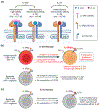Harnessing CD8 T cell responses using PD-1-IL-2 combination therapy
- PMID: 38129234
- PMCID: PMC11006586
- DOI: 10.1016/j.trecan.2023.11.008
Harnessing CD8 T cell responses using PD-1-IL-2 combination therapy
Abstract
There is considerable interest in developing more effective programmed cell death (PD)-1 combination therapies against cancer. One major obstacle to these efforts is a dysfunctional/exhausted state of CD8 T cells, which PD-1 monotherapy is not able to overcome. Recent studies have highlighted that PD-1+ T cell factor (TCF)-1+ stem-like CD8 T cells are not fate locked into the exhaustion program and their differentiation trajectory can be changed by interleukin (IL)-2 signals. Modifying the CD8 T cell exhaustion program and generating better effectors from stem-like CD8 T cells by IL-2 form the fundamental immunological basis for combining IL-2 with PD-1 therapy. Many versions of IL-2-based products are being tested and each product should be carefully evaluated for its ability to modulate dysfunctional states of anti-tumor CD8 T cells.
Keywords: IL-2; PD-1; T cell exhaustion; cancer; chronic infection; immunotherapy.
Copyright © 2023 Elsevier Inc. All rights reserved.
Conflict of interest statement
Declaration of interests M.H. declares no competing interests. S.S.R. is a consultant and/or on the advisory boards for AstraZeneca, Bristol Myers Squibb, Merck, Amgen, Roche, GlaxoSmithKline, Advaxis, Genmab, and Takeda, and is also an executive director of Winship Cancer Institute, which receives research support from AstraZeneca, Bristol Myers Squibb, Merck, Amgen, Roche, GlaxoSmithKline, Advaxis, Genmab, and Takeda. R.A. has patents related to the PD-1 pathway (8,652,465 and 9,457,080) licensed to Roche.
Figures




References
Publication types
MeSH terms
Substances
Grants and funding
LinkOut - more resources
Full Text Sources
Medical
Research Materials

